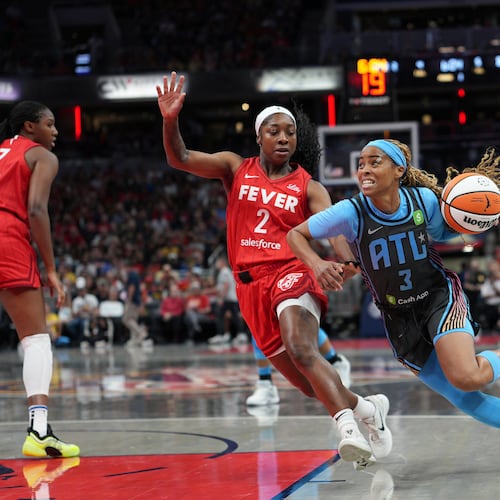Philips Arena, in the spotlight this week as a site of March Madness, is down to its final month of operation in its current form.
On April 22 – exactly one month after Thursday’s NCAA South Regional semifinals – the 19-year-old arena will close for about six months for the last and largest phase of ongoing renovations. When it reopens in the fall for the start of the Hawks’ 2018-19 season, the arena will be dramatically transformed, if all goes according to plan.
“From roof line to baseline, every element will be different,” said Steve Koonin, the Hawks’ CEO.
“We will have close to 800 construction workers on a daily basis during the summer,” said Brett Stefansson, general manager of the Hawks-operated arena.
The magnitude of the makeover is apparent in a visit to a new appointment-only preview center the Hawks recently opened at CNN Center -- a dramatic, high-tech space designed to showcase (and sell) suites and other premium amenities not yet built.
The $192.5 million renovation began last summer with what the Hawks called Phase 1: the demolition of a six-level wall of suites on the west side of the arena and the addition of a court-side club behind one basket, as well as prep work for much construction to come. Phase 2 – "close to $30 million worth of work," according to Stefansson -- has proceeded behind the scenes during this basketball season, with up to 150 construction workers on site daily.
Phase 3, the culmination of the project, is scheduled to begin 12 days after the Hawks’ final game this season and one day after an April 21 Pink concert.
“We’ll have six months to finish, but fortunately the infrastructure is already there,” Koonin said. “They cut the beams, did the support work, all that stuff, last summer. Now it is really cosmetics.”
While the first two phases have revealed little more than hints about the ultimate transformation, the next phase will lead to the finished product, which will feature a wide range of non-traditional premium seating areas (think couches and cabanas), a sharply reduced number of (reimagined) suites, several new clubs (one with a view of postgame news conferences), a new center-hung video board three times the size of the current board, 360-degree open concourses, even a barber shop and Topgolf simulators.
Public funds are paying for $142.5 million of the project’s cost, mostly from Atlanta’s rental-car tax, with the Hawks responsible for the other $50 million.
High-tech exhibits in the preview center show off the renovated arena’s openness and amenities, which will range from Killer Mike’s barbershop to Zac Brown’s restaurant to premium space Atlanta Social.
The latter, which will reinvent the current 200 level on the arena’s east side, will be outfitted with private cabanas, banquettes, overstuffed couches – all with prime views of the court and sold as season tickets. It’s an elevation of the trend in sports venue design toward social gathering spaces where fans can interact outside traditional stadium seats.
When the makeover is completed, the arena’s seating capacity will be about 17,500, according to Koonan. The Hawks list this season’s capacity as 15,711, down from 18,047 before renovations began. Many of the lost seats will be regained when the former wall of suites is repurposed with two levels of suites (“Veranda suites” on one row, “loft suites” on the other), Topgolf and new upper-deck seating.
Among the changes coming to the arena, Koonin pointed out at the preview center, is that the Hawks’ and visitors’ benches will flip-flop locations next season, positioning the home team so that it passes within view of one of the new clubs, the “Players Club,” en route to the court. From the same club, fans will be able to view and listen to postgame news conferences.
One piece of the redesigned Philips Arena remains up in the air: its future name.
The Hawks' 20-year naming-rights deal with technology company Philips expires after the 2018-19 season, and the Netherlands-based company doesn't plan to renew it. The Hawks are in the market actively seeking a new naming-rights partner.
Koonin said there has been “a lot of interest” from potential partners, “but no deal is imminent.”
He declined to discuss whether there’s a possibility of ending the Philips deal one year early to align a new name with the completion of renovations this fall, seemingly a logical time for such a rebranding.
Philips largely exited the consumer electronics business in 2013 and has transitioned to a health technology and lighting company with less need for an expensive sports naming-rights deal.
“Philips has a contract in place with Philips Arena until 2019,” company spokeswoman Silvie Casanova said by email last month, “and the company does not speculate on future contracts.”
Philips Arena’s size – about 650,000 square feet – will remain the same after renovations are done, but about 100,000 square feet of space not previously accessible to the public will be transformed into “fan space,” Stefansson said. For example, the space that previously housed the Hawks’ basketball-operations offices will become a premium club. (The offices moved to the team’s new training facility in Brookhaven).
The Hawks bucked a trend in Atlanta professional sports with their decision to renovate, rather than replace, the arena. The Falcons and Braves left a 25-year-old Georgia Dome and a 20-year-old Turner Field for Mercedes-Benz Stadium and SunTrust Park, respectively.
Koonin said it would have cost $550 million, plus the cost of land, for the Hawks to build a new arena from scratch. He figures more than $350 million will be saved by instead remaking the interior under the same roof and within the same exterior walls and largely keeping the existing electrical, plumbing and heating/air conditioning systems intact.
Next season’s NBA schedule hasn’t been announced, so the Hawks don’t know exactly when the renovated arena will debut. But the construction schedule calls for the work to be completed Oct. 15, Stefansson said.
To this point, the Hawks have taken a somewhat lower public profile with the project than the Falcons and Braves took in early marketing of their new stadiums. The Hawks are about to turn up the volume.
“We have been pretty quiet about it,” Koonin said. “I think we were absolutely right in waiting. You had a lot of news in 2017 in the Atlanta market about stadium product. You have nothing new in 2018 but us.”
So the Hawks’ official website now refers unabashedly to the renovated Philips as “the best sports and live entertainment venue in Atlanta opening October 2018.”
Credit: ccompton@ajc.com
Credit: ccompton@ajc.com
Credit: ccompton@ajc.com
Credit: ccompton@ajc.com
Credit: ccompton@ajc.com
Credit: ccompton@ajc.com
About the Author
Keep Reading
The Latest
Featured





